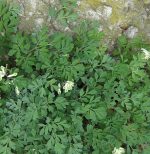 Plants that prefer good drainage are excellent subjects for inclusion in wall gardens especially if they are small so they can be tucked into crevices. The plants soften the look of a wall with their foliage and can add color with their flowers. Some may have a trailing habit and spill gracefully down the wall while others will be more reserved but beautiful none the less. The conditions in a wall garden are challenging as there is usually little soil and nutrition may be low. A shady aspect may restrict the plants that can be grown many beautiful plants appreciate the coolness that the shade affords. Here are 5 herbaceous perennials that will do well in the crevices of a wall garden in part shade. Check climbers for part shade for more plant suggestions. Photo Credit: Wikimedia
Plants that prefer good drainage are excellent subjects for inclusion in wall gardens especially if they are small so they can be tucked into crevices. The plants soften the look of a wall with their foliage and can add color with their flowers. Some may have a trailing habit and spill gracefully down the wall while others will be more reserved but beautiful none the less. The conditions in a wall garden are challenging as there is usually little soil and nutrition may be low. A shady aspect may restrict the plants that can be grown many beautiful plants appreciate the coolness that the shade affords. Here are 5 herbaceous perennials that will do well in the crevices of a wall garden in part shade. Check climbers for part shade for more plant suggestions. Photo Credit: Wikimedia
Sandwort (Arenaria balearica)
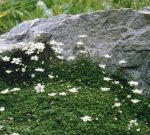 This creeping evergreen perennial is native native to the Balearic Islands, Corsica, Sardinia and mainland Italy. It grows 1/2-1″ tall and froms a dense moss-like carpet of tiny green leaves. In late spring and early summer short stems bear tiny star-like flowers with 5 pure white petals. Plants need partial shade and well-drained soil that does not dry out in summer and are a good choice for alpine troughs, between paving stones and for rock, alpine, and wall gardens.
This creeping evergreen perennial is native native to the Balearic Islands, Corsica, Sardinia and mainland Italy. It grows 1/2-1″ tall and froms a dense moss-like carpet of tiny green leaves. In late spring and early summer short stems bear tiny star-like flowers with 5 pure white petals. Plants need partial shade and well-drained soil that does not dry out in summer and are a good choice for alpine troughs, between paving stones and for rock, alpine, and wall gardens.
Type: Evergreen perennial
Bloom Time: Late spring and early summer
Height: 1/2-1″
Soil: Average, consistantly moist, well-drained
Hardiness: Zones 5-9
Photo Credit: Ghislain Wikipedia
Lamb’s Tail (Chiastophyllum oppositifolium)
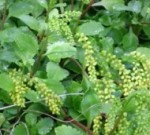 Native to limestone outcroppings in shady mountin areas of the Caucasus, this rhizomateous perennial succulent slowly grows to form a low mound of large fleshy ovate leaves with scalloped edges. Upright racemes of dangling pea-like flowers emerge well above the foliage in spring and early summer. The plants are suitable for shade gardens and rock gardens, and are especially attractive when growing in walls or between flagstones. They are also good edgers and mix well with other plants in containers.
Native to limestone outcroppings in shady mountin areas of the Caucasus, this rhizomateous perennial succulent slowly grows to form a low mound of large fleshy ovate leaves with scalloped edges. Upright racemes of dangling pea-like flowers emerge well above the foliage in spring and early summer. The plants are suitable for shade gardens and rock gardens, and are especially attractive when growing in walls or between flagstones. They are also good edgers and mix well with other plants in containers.
Type: Succulent perennial
Bloom Time: Spring and early summer
Height: 6-8″
Soil: Poor to moderately fertile, moist, well-drained
Hardiness: Zones 5-9
White Corydalis (Corydalis ochroleuca aka Pseudofumaria alba)
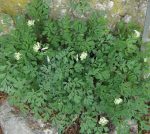 This short-lived evergreen perennial is native to Italy and the Balkans where it grows in rocky woodland areas. Plants form a 12-20″ tall mound of finely divided, gray-green, fern-like leaves. From spring to autumn, fleshy branched stems carry axillary racemes of pendulous, 4-petaled flowers that are white with pale yellow throats. Each flower is fragrant, 5/8″ long, and tubular with a spur on one end. Plants do best in dappled sun in cool climates.
This short-lived evergreen perennial is native to Italy and the Balkans where it grows in rocky woodland areas. Plants form a 12-20″ tall mound of finely divided, gray-green, fern-like leaves. From spring to autumn, fleshy branched stems carry axillary racemes of pendulous, 4-petaled flowers that are white with pale yellow throats. Each flower is fragrant, 5/8″ long, and tubular with a spur on one end. Plants do best in dappled sun in cool climates.
Type: Evergreen herbaceous perennial
Bloom Time: Spring to autumn
Height: 12-20″
Soil: Humus-rich, consistently moist, well-drained
Hardiness: Zones 5-7
Photo Credit:Wikimedia
Lewisia ‘George Henley’
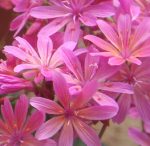 Lewisias are herbaceous perennials native to north facing cliffs in western North America. This cultivar is clump-forming, evergreen and grows up to 6″ tall. It forms rosettes of spoon-shaped dark green leaves that are fleshy, waxy, and up to 3″ long. In late spring and summer loose cymes of conical, purple-pink flowers with magenta veins appear. Plants are best grown in a wall crevice or scree but are also a good choice for alpine and rock gardens.
Lewisias are herbaceous perennials native to north facing cliffs in western North America. This cultivar is clump-forming, evergreen and grows up to 6″ tall. It forms rosettes of spoon-shaped dark green leaves that are fleshy, waxy, and up to 3″ long. In late spring and summer loose cymes of conical, purple-pink flowers with magenta veins appear. Plants are best grown in a wall crevice or scree but are also a good choice for alpine and rock gardens.
Type: Evergreen herbaceous perennial
Bloom Time: Late spring and summer
Height: 6″
Soil: Average, medium moist, very well-drained
Hardiness: Zones 5-8
Pyrenean-Violet (Ramonda myconi)
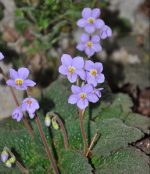 Also known as rosette mullein, this evergreen perennial is native to rocky soils in the Pyrenees and north eastern Spain. Plants grow 3-4″ tall and form rosettes of crinkly, hairy, dark green leaves that are broadly ovate and have prominent veins. In late spring and early summer leafless stems carry clusters of 1″ wide flowers with violet-blue petals and conspicuous yellow anthers.
Also known as rosette mullein, this evergreen perennial is native to rocky soils in the Pyrenees and north eastern Spain. Plants grow 3-4″ tall and form rosettes of crinkly, hairy, dark green leaves that are broadly ovate and have prominent veins. In late spring and early summer leafless stems carry clusters of 1″ wide flowers with violet-blue petals and conspicuous yellow anthers.
Type: Evergreen herbaceous perennial
Bloom Time: Late spring to early summer
Height: 3-4″
Soil: Average, moderately moist, well-drained
Hardiness: Zones 5-7
Photo Credit: Wikimedia Commons
oto Credit: